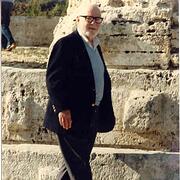Thomas Albert Sebeok (1920–2001)
Author of The Sign of Three. Peirce, Holmes, Dupin
About the Author
Thomas A. Sebeok is Distinguished Professor Emeritus of Linguistics and Semiotics at Indiana University.
Series
Works by Thomas Albert Sebeok
Signs: An Introduction to Semiotics (Toronto Studies in Semiotics and Communication) (1994) 65 copies
Approaches to semiotics: cultural anthropology, education, linguistics, psychiatry, psychology; transactions (2015) 7 copies
Speaking of apes : a critical anthology of two-way communication with man (1980) — Editor; Editor — 6 copies
American Signatures: Semiotic Inquiry and Method (Oklahoma Project for Discourse and Theory) (1991) 5 copies
Aboriginal Sign Languages of The Americas and Australia Volume 1; North America Classic Comparative Perspectives (2013) 5 copies
The Forms of Meaning: Modeling Systems Theory and Semiotic Analysis (Approaches to Applied Semiotics) (2000) 4 copies
Encyclopedic Dictionary of Semiotics: Tome 1 : A-M, Tome 2 : N-Z, Tome 3 : Bibliography (Approaches to Semiotics) (1986) 3 copies
Portraits of linguists; a biographical source book for the history of western linguistics, 1746-1963, vol. I (1976) 3 copies
Current Trends in linguistics, Volume 11: Diachronic, Areal, and Typological Linguistics (1973) — Editor — 2 copies
Current Trends in Linguistics, Volume 12: Linguistics and Adjacent Arts and Sciences (2019) 2 copies
Portraits of linguists: a biographical source book for the history of western linguistics, 1746-1963 (2 Bde.) (2002) 2 copies
Speaking of Apes: A Critical Anthology of Two-Way Communication with Man (Topics in Contemporary Semiotics) (Topics in… (2012) 1 copy
Jakobson [acrylic] 1 copy
The Invention of Global Semiotics : A Collection of Essays on the Life and Work of Thomas A. Sebeok (2001) 1 copy
Animal communication 1 copy
Essays in Zoosemiotics. 1 copy
Il segno e i suoi maestri 1 copy
Il gioco del fantasticare 1 copy
Associated Works
Studies in diachronic, synchronic, and typological linguistics : festschrift for Oswald Szemerényi on the occasion of… (1979) — Contributor — 6 copies
Functional approaches to language, culture, and cognition papers in honor of Sydney M. Lamb (2000) — Contributor — 3 copies
Current Trends in Linguistics, Volume 2: Linguistics in East Asia and South East Asia (1967) — Series Editor — 2 copies
Current Trends in Linguistics, Volume 4: Ibero-American and Caribbean Linguistics (1968) — Series Editor — 2 copies
Current Trends in Linguistics, Volume 6: Linguistics in South West Asia and North Africa — Series Editor — 1 copy
Current Trends in Linguistics, Volume 7: Linguistics in Sub-Saharan Africa — Series Editor — 1 copy
Current Trends in Linguistics, Vol. 8: Linguistics in Oceania part 2 (1971) — Series Editor — 1 copy
Tagged
Common Knowledge
- Canonical name
- Sebeok, Thomas Albert
- Birthdate
- 1920-11-09
- Date of death
- 2001-12-21
- Gender
- male
- Nationality
- USA
- Birthplace
- Budapest, Ungarn
- Place of death
- Bloomington, Indiana, USA
- Occupations
- Semiotiker
- Relationships
- Morris, Charles William (Lehrer)
Members
Reviews
You May Also Like
Associated Authors
Statistics
- Works
- 83
- Also by
- 10
- Members
- 630
- Popularity
- #39,984
- Rating
- 4.2
- Reviews
- 5
- ISBNs
- 118
- Languages
- 5
- Favorited
- 1













Peirce realized that the formation of useful hypotheses, the fuel of scientific discovery and explanation in general, is neither formal induction nor deduction but rather what he termed abduction: informed and testable guesses. And whereas induction and deduction are subject to mathematically exact rules of formal logic, no formal rule can comprise useful abduction.
Finding and testing a provisional hypothesis does require the engines of induction and deduction: working out natural consequences implied or deducible from a hypothesis to discover whether those consequences comport with facts. If not, then the hypothesis is in error.
Arthur Conan Doyle let Holmes call his methods variously induction and deduction, but they were rather choosing from multiple hypotheses by eliminating the wrong ones by testing their various consequences. Poe called this ratiocination in the case of Dupin. Holmes's capacities appeared astonishing to Dr. Watson because Watson did not entertain the wealth of Holmes's hypotheses so as to recognize the significance of certain evident facts, nor the chain of their ramifications and of Holmes's testing of them, only to be revealed later. Of course, Holmes benefitted also from a personal fund of forensic facts, like the sources of all kinds of tobaccos, ability to recognize most perfumes, and where different types of dirt were found in London.
The Sherlock Holmes stories are a delight and a fast read. I read one in college and could not resist reading all the rest one weekend.
Peirce is a fine thinker and writer. Wikisource carries a free set of his quite readable and wryly humorous essays along the above lines at:
https://en.wikisource.org/wiki/Popular_Science_Monthly/Volume_12/January_1878/Il... .… (more)